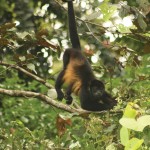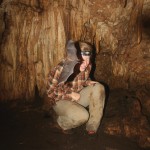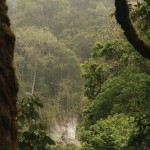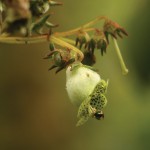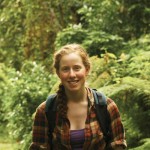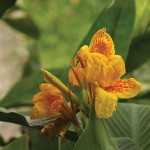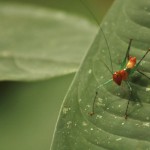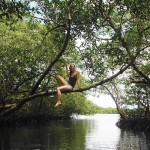By Rebecca Lerch
After much encouragement from my mother, I finally took the time to sit down and write about my recent trip to Panama. On May 2nd, I was a part of a group of eleven students along with a TA and a professor from the University of Northern BC who spent three and a half weeks in Panama for a six credit Bio333/498 Tropical Ecology Field course.
After landing in Panama City quite late the first evening and being welcomed by the warm, sticky, and humid air we slept in a hostel for that night and then departed to the island of Bocas del Toro the following day. This transportation involved the excitement of very high turbulence during the one hour flight, and getting struck by lightning while in the plane, where it occurred by the sudden bright flash of light and a loud clash, followed by utter silence of all the people on board. While I am sure others beg to differ, I actually found it quite spectacular. We were picked up from the mini airport by a raggedy bus that dropped us off on the ocean side, followed by a ten minute boat ride over a section of the Bay of Almirante, in the Caribbean Sea. After passing through a mangrove forest canal we were welcomed by the herd of cows and one moody horse that lived in the meadow situated between the dock and the field station. For the next three weeks we would call this station within the jungle our home.
Each morning we would wake up quite early (often much earlier than intended due to the shrill cries of the howler monkeys accompanied by the calls of one species of tropical birds, the Montezuma oropendola ), and would begin our day. Each day we went out on different expeditions. We did coral reef surveys, leaf cutter ant colony observations and data collections, plant size and diversity studies, explored a limestone cave filled with four different kinds of bats and also had to come up with our own research projects. My project involved studying the epiphytes (which are any plants that grow on another plant), that were found in one tree and then comparing the diversity and size of them from the sunny to the shady side of the tree. This proved to be slightly more challenging that I had anticipated, after termites which were present all over the tree decided to attack my bare feet while I was climbing around on the tree branches. Much more caution was also taken after the discovery of a vine snake which called this tree its home. It was rewarding to find that the data I had collected were statistically significant.
For several days during the time in Panama, we went to Boquette, which was situated closer to the Pacific side of Panama. It was slightly cooler there, and we got to experience a nice hike to a cloud forest, relax in a river with natural hot-springs nearby, and lived through a miniature earthquake.
Though the days were long and little sleep was to be had after late nights of staying up to fill out field journals by headlamp with giant moths dive bombing our faces, and marine toads and heavy rain pours and thunderstorms creating sleepless nights, there was still some free time to do some. The canoe stored at the dock became a favourite for going through the mangroves or out onto the Caribbean, often followed by a late night jungle adventure. Numerous times these involved frogs bouncing down my shirt, white-faced capuchins hurling massive wood chunks towards us from the high canopy up above, and huge brown shiny cockroaches adventuring up my pant legs into another dark world. Throughout each exploration it was simply unbelievable how much life there is throughout the rainforest and I quickly learned how every plant has hidden spines growing on it, that will tear apart any exposed skin. Wanting to go on a thirty minute exploration of the jungle often resulted in only several metres of jungle floor being covered, as there was unexplainable amount of life present from every crack on the huge buttress roots, to the stems and leaves of massive vegetation, to the high up canopy allowing only slivers on light to shine through. Some unpleasant souvenirs that were left with me during my first snorkeling survey were the needle-thin spines of a sea urchin which painfully found their way into my knee and are still causing trouble these many weeks later. All a learning process I guess!
One spectacular adventure took place from around 6PM until midnight one day. In the dark, we walked up and down the shoreline along a section of the Caribbean looking for the giant leatherback sea turtles that were coming to shore during these weeks to lay their eggs. They are sadly becoming more rare every year due to heavy poaching. We had to keep all lights out to avoid disturbing them and relied on seeing a disturbance in the black volcanic sand along the shore to indicate a turtle’s presence. We ended up observing two of these massive creatures digging their nests to lay white golf-ball sized eggs and then slowly dragging their heavy bodies back to the water. Earlier that day I had the privilege of climbing 90 feet up into the canopy on a rope and being face to face with some monkeys. The evening, with dry lightning continuing all night, rough seas, and bioluminescent water glowing after being disturbed by flying fish scurrying along the water surface, along with the amazement of seeing these endangered sea turtles, was truly a major highlight.
With the workload of doing studies, writing papers and giving presentations as well as keeping a detailed field journal, this trip was by far not a holiday as many people assumed when they heard I was going to Panama. It was more interesting and adventurous though than I would ever have imagined and my eyes and interests in this world of research were greatly opened. This field course was only a small taste of how different the world in the tropical rainforest is, with endless different colours, noises, and incredible life and will be something that I cannot easily forget. Thus, I hope to return in the future for more studies in this mysterious and unknown habitat full of constant surprises and never ending experiences.



